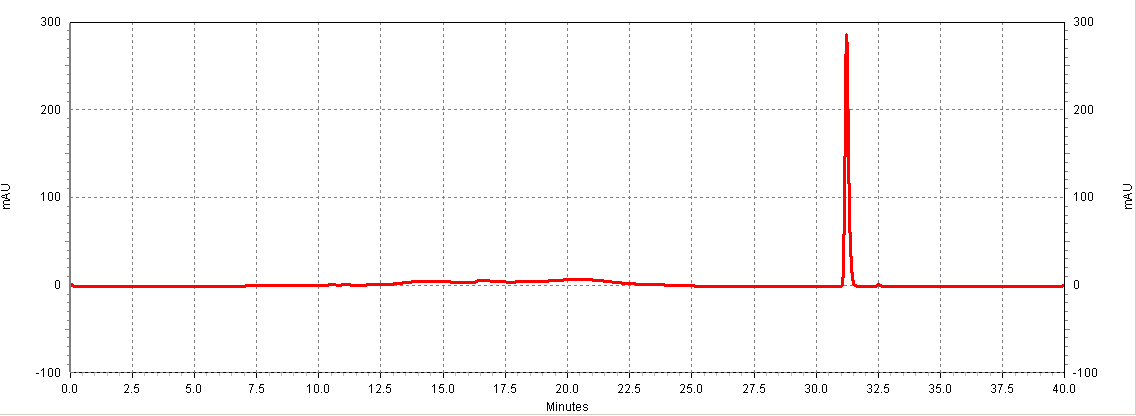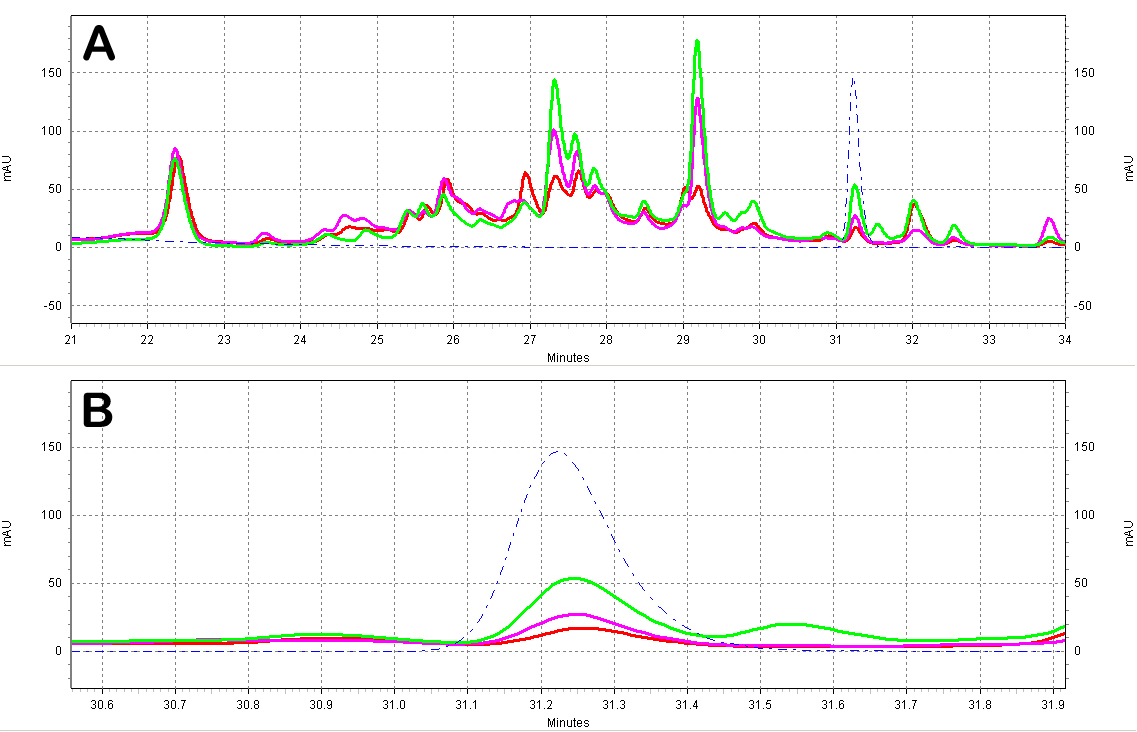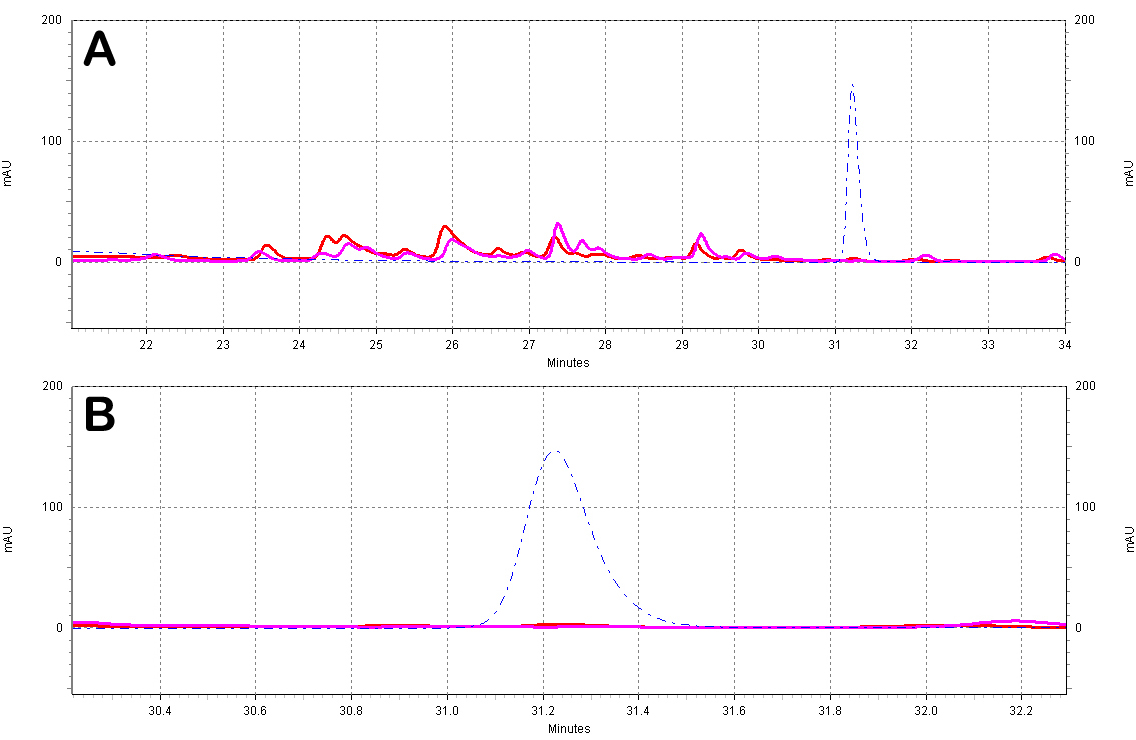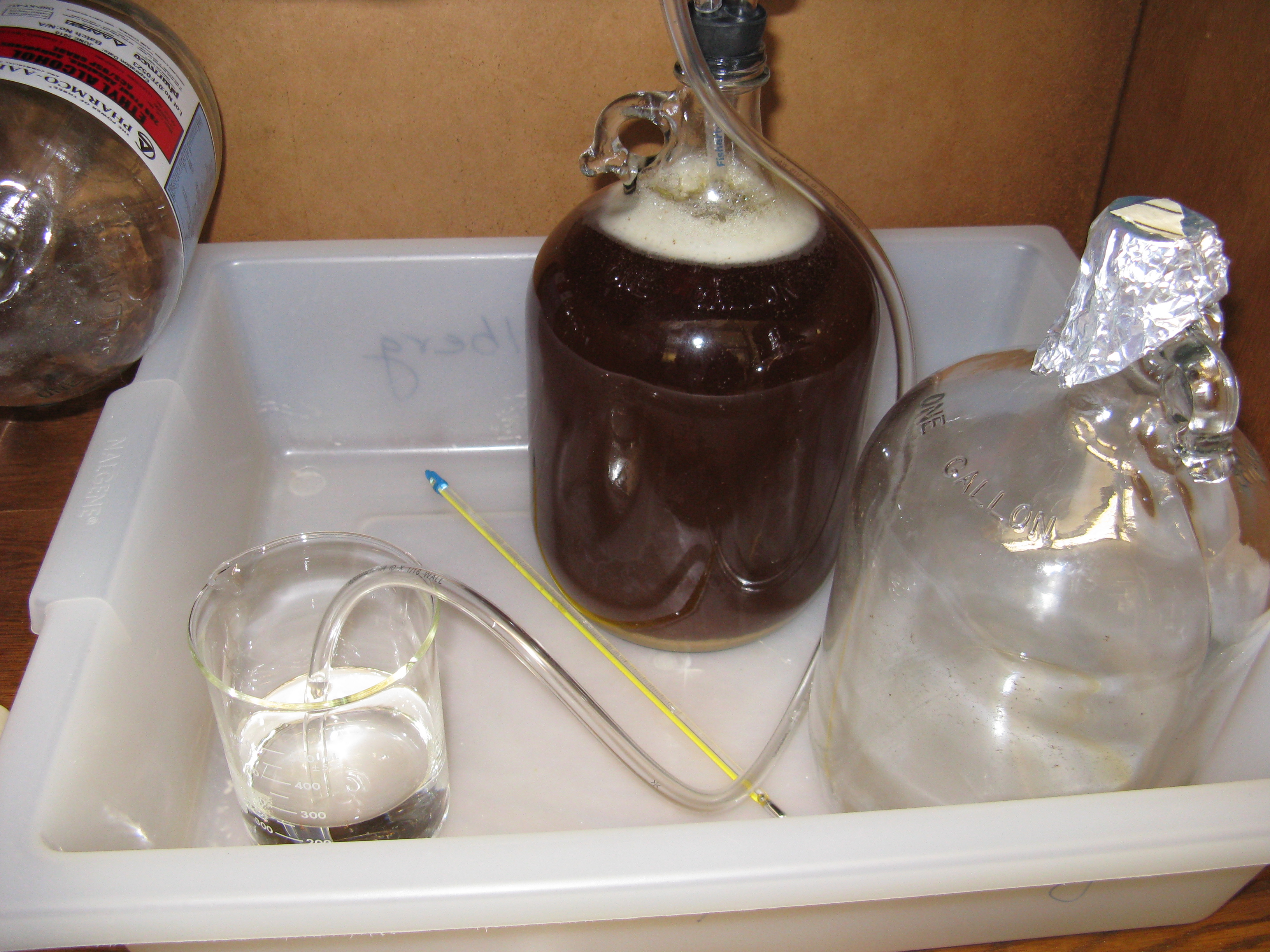Team:Rice University/RESULTS
From 2008.igem.org
(→HPLC: Wine Extract Tests) |
(→C. HPLC Data) |
||
| Line 27: | Line 27: | ||
=== C. HPLC Data=== | === C. HPLC Data=== | ||
| - | To analyze our beer samples for resveratrol content, be will be using '''H'''igh '''P'''erformance '''L'''iquid '''C'''hromatography (HPLC), which will allow us to separate the metabolites produced by the yeast and analyze these compounds by spectrophotometry. By comparing HPLC chromatogram peaks of metabolites produced by our yeast with a resveratrol-only standard, we can identify if resveratrol is being produced, and at what quantities. We will be monitoring the production of resveratrol and the consumption of p-coumaric acid, which will only be added to the media for the 4CL::STS-integrated yeast; the 4CL::STS+TAL . Below, we show our initial data for HPLC calibration curves using known quantities of resveratrol and p-coumaric acid standards and test chromatograms using extracts from different wine samples. | + | To analyze our beer samples for resveratrol content, be will be using '''H'''igh '''P'''erformance '''L'''iquid '''C'''hromatography (HPLC), which will allow us to separate the metabolites produced by the yeast and analyze these compounds by spectrophotometry. By comparing HPLC chromatogram peaks of metabolites produced by our yeast with a resveratrol-only standard, we can identify if resveratrol is being produced, and at what quantities. We will be monitoring the production of resveratrol and the consumption of ''p''-coumaric acid, which will only be added to the media for the 4CL::STS-integrated yeast; the 4CL::STS+TAL . Below, we show our initial data for HPLC calibration curves using known quantities of ''trans''-resveratrol and ''p''-coumaric acid standards and test chromatograms using extracts from different wine samples. |
{|align="center" style="background-color:#FFFF99; text-align:left" border="1" cellpadding="0" width="50%" | {|align="center" style="background-color:#FFFF99; text-align:left" border="1" cellpadding="0" width="50%" | ||
| Line 42: | Line 42: | ||
::''Sample injection volume'': 25 microliters | ::''Sample injection volume'': 25 microliters | ||
|}<BR> | |}<BR> | ||
| - | [[Image:HPLC_RSV_example.jpg|center|thumb|600px|'''Figure C1. Example HPLC chromatogram of a trans-resveratrol standard.''']] | + | [[Image:HPLC_RSV_example.jpg|center|thumb|600px|'''Figure C1. Example HPLC chromatogram of a ''trans''-resveratrol standard.''']] |
<BR> | <BR> | ||
===== HPLC: Calibration===== | ===== HPLC: Calibration===== | ||
| - | [[Image:RSV_standards.jpg|center|thumb|600px|'''Figure C2: trans-resveratrol standards (Sigma).''' Different serial dilutions are shown: 20 ug/mL (red), 10ug/mL (purple), 5ug/mL (blue), 2.5ug/mL (green).]]<BR> | + | [[Image:RSV_standards.jpg|center|thumb|600px|'''Figure C2: ''trans''-resveratrol standards (Sigma).''' Different serial dilutions are shown: 20 ug/mL (red), 10ug/mL (purple), 5ug/mL (blue), 2.5ug/mL (green).]]<BR> |
| - | [[Image:Coumaric_standards.jpg|center|thumb|600px|'''Figure C3: p-Coumaric acid standards (Sigma).''' Different serial dilutions are shown: 18.5ug/mL (red), 9.25ug/mL (purple), 4.63ug/mL (blue), 2.3ug/mL (green).]]<BR> | + | [[Image:Coumaric_standards.jpg|center|thumb|600px|'''Figure C3: ''p''-Coumaric acid standards (Sigma).''' Different serial dilutions are shown: 18.5ug/mL (red), 9.25ug/mL (purple), 4.63ug/mL (blue), 2.3ug/mL (green).]]<BR> |
| - | [[Image:RSVandCoumaric.jpg|center|thumb|600px|'''Figure C4: trans-resveratrol and p-coumaric acid have different retention times.''' This separation will allow us to resolve both molecules in a complex mixture, such as a yeast extract. Shown is 18.5ug/mL of p-coumaric acid and 20ug/mL of trans-resveratrol.]]<BR> | + | [[Image:RSVandCoumaric.jpg|center|thumb|600px|'''Figure C4: ''trans''-resveratrol and ''p''-coumaric acid have different retention times.''' This separation will allow us to resolve both molecules in a complex mixture, such as a yeast extract. Shown is 18.5ug/mL of p-coumaric acid and 20ug/mL of trans-resveratrol.]]<BR> |
===== HPLC: Wine Extract Tests===== | ===== HPLC: Wine Extract Tests===== | ||
:* All wine samples were extracted using 6 volumes of ethyl acetate. The ethyl acetate extracts were then evaporated under vacuum and resuspended with 70% methanol. Samples were kept in light-protected tubes until analysis. | :* All wine samples were extracted using 6 volumes of ethyl acetate. The ethyl acetate extracts were then evaporated under vacuum and resuspended with 70% methanol. Samples were kept in light-protected tubes until analysis. | ||
| - | :* The results clearly show that red wines (Fig. C5) contain resveratrol in significant amounts, whereas white wines (Fig. C6) do not, as expected. | + | :* The results clearly show that red wines (Fig. C5) contain ''trans''-resveratrol in significant amounts, whereas white wines (Fig. C6) do not, as expected. |
<BR> | <BR> | ||
| - | [[Image:Red_Wine_Samples.jpg|center|thumb|650px|'''Figure C5: Red wine extracts analyzed by HPLC.''' A)Chromatogram of the red wine extracts; the different wines shown are a Merlot from ''Australia'' (red), a Shiraz from ''Australia'' (green), and a Primitivo from ''S. Italy'' (purple). Also shown is a trans-resveratrol standard (10ug/mL, blue dotted line). B)Zoomed-in view of the resveratrol peak region.]] | + | [[Image:Red_Wine_Samples.jpg|center|thumb|650px|'''Figure C5: Red wine extracts analyzed by HPLC.''' A)Chromatogram of the red wine extracts; the different wines shown are a Merlot from ''Australia'' (red), a Shiraz from ''Australia'' (green), and a Primitivo from ''S. Italy'' (purple). Also shown is a ''trans''-resveratrol standard (10ug/mL, blue dotted line). B)Zoomed-in view of the resveratrol peak region.]] |
<BR> | <BR> | ||
| - | [[Image:White_Wine_Samples.jpg|center|thumb|650px|'''Figure C5: White wine extracts analyzed by HPLC.''' A)Chromatogram of the white wine extracts; the different wines shown are a Sauvignon Blanc from ''France'' (red) and a Chardonnay from ''N. California'' (purple). Also shown is a trans-resveratrol standard (10ug/mL, blue dotted line). B)Zoomed-in view of the resveratrol peak region.]] | + | [[Image:White_Wine_Samples.jpg|center|thumb|650px|'''Figure C5: White wine extracts analyzed by HPLC.''' A)Chromatogram of the white wine extracts; the different wines shown are a Sauvignon Blanc from ''France'' (red) and a Chardonnay from ''N. California'' (purple). Also shown is a ''trans''-resveratrol standard (10ug/mL, blue dotted line). B)Zoomed-in view of the resveratrol peak region.]] |
===== HPLC: Fermenation batches===== | ===== HPLC: Fermenation batches===== | ||
Revision as of 03:01, 30 October 2008
|
|
 "
"









